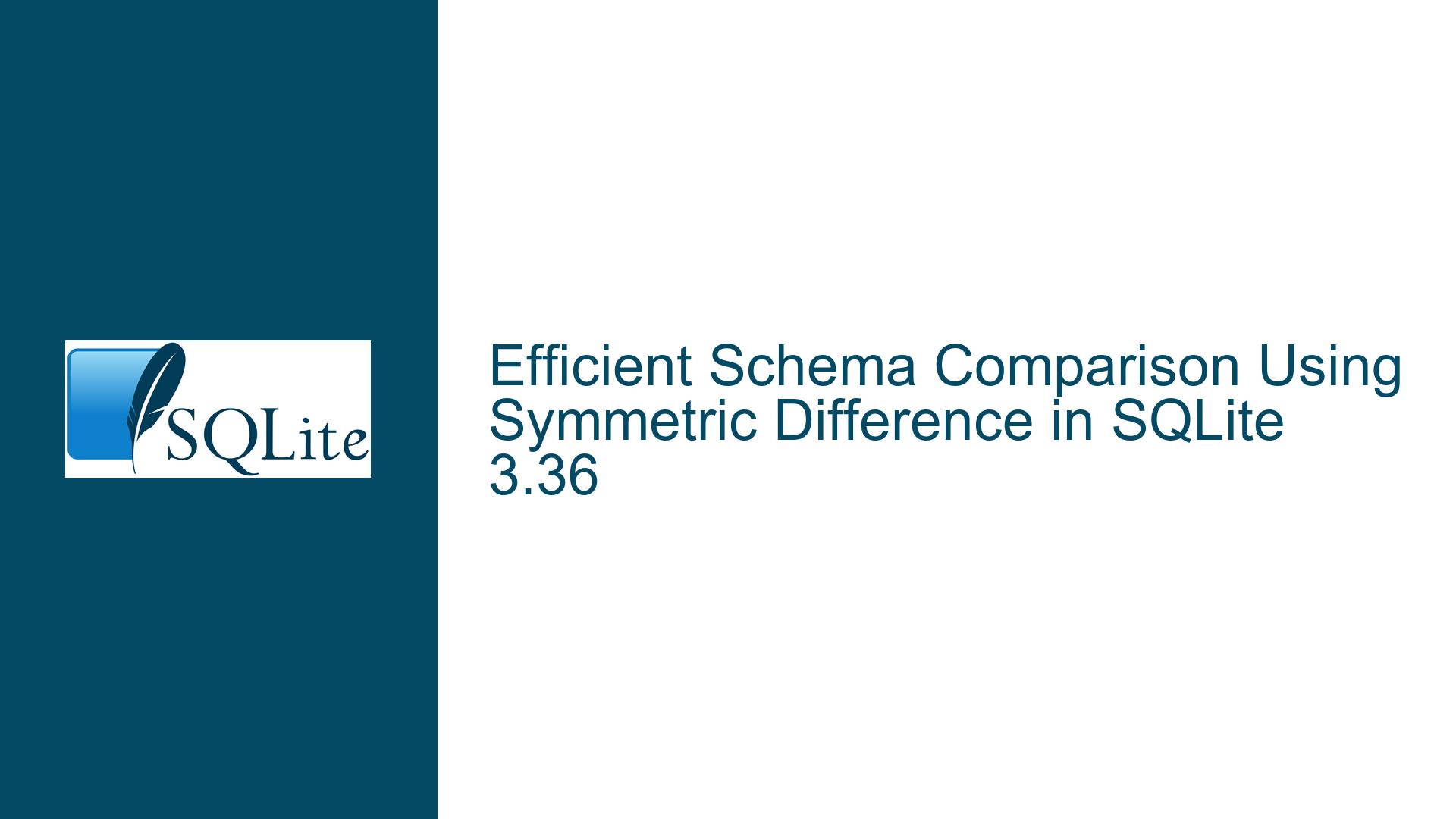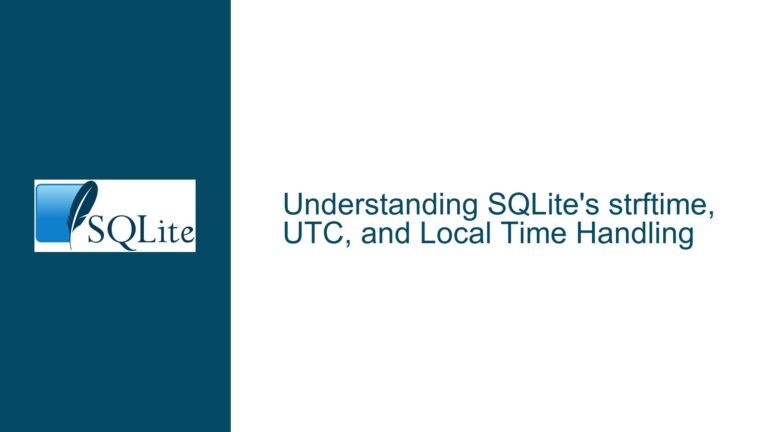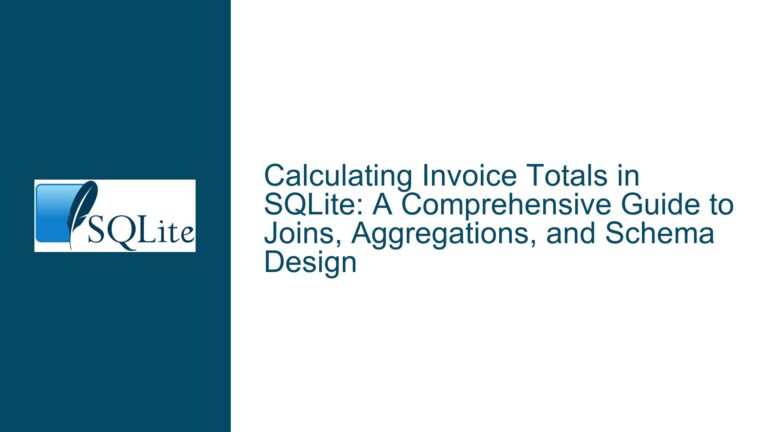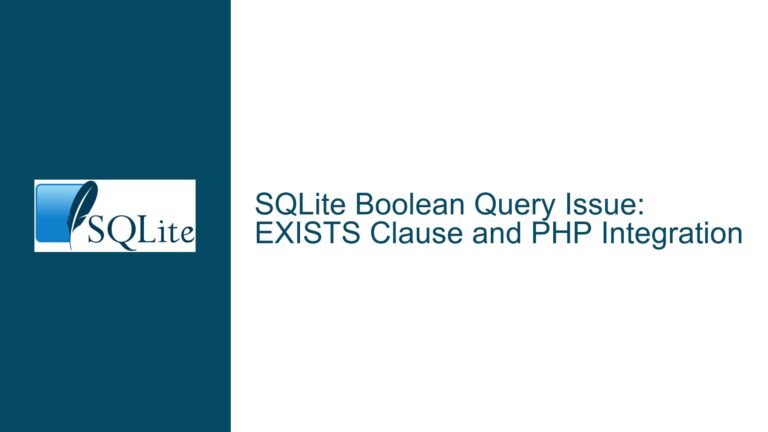Efficient Schema Comparison Using Symmetric Difference in SQLite 3.36
Understanding Symmetric Difference Requirements for Cross-Database Schema Validation
Core Objective
The problem involves comparing schema objects between two SQLite databases to identify discrepancies using symmetric difference (XOR) logic. The goal is to detect objects (tables, indexes, triggers, etc.) that exist in one database but not the other while excluding system tables (those prefixed with sqlite). The challenge arises from SQLite 3.36’s lack of native support for FULL OUTER JOIN and the need to avoid code repetition in queries.
The solution must:
- Exclude system tables using
name NOT LIKE 'sqlite%'. - Compare schemas across attached databases (e.g.,
mainvs. another attached database). - Handle dynamic queries where column lists may vary (e.g., comparing table structures vs. indexes).
- Minimize code duplication while maintaining compatibility with SQLite 3.36.
Critical Analysis of Proposed Solutions and Their Limitations
Solution 1: EXCEPT + UNION ALL with Repeated Subqueries
The original approach uses two EXCEPT operations combined with UNION ALL:
SELECT ... FROM main.sqlite_master EXCEPT SELECT ... FROM attached_db.sqlite_master
UNION ALL
SELECT ... FROM attached_db.sqlite_master EXCEPT SELECT ... FROM main.sqlite_master
Strengths:
- Directly implements XOR logic.
- Works without
FULL OUTER JOIN.
Weaknesses:
- Code repetition: Four instances of the base query.
- Maintainability risk: Changes to column lists require updates in multiple places.
Solution 2: UNION ALL + GROUP BY with HAVING count(*) = 1
David Raymond’s proposal aggregates results from both databases and filters rows appearing only once:
SELECT ... FROM (
SELECT ... FROM main.sqlite_master
UNION ALL
SELECT ... FROM attached_db.sqlite_master
)
GROUP BY type, name, tbl_name
HAVING count(*) = 1
Strengths:
- Eliminates code repetition.
- Simplifies syntax.
Weaknesses:
- False negatives: If duplicate rows exist in one database (e.g., two identical entries),
count(*) = 1may incorrectly flag them. - Column ambiguity:
GROUP BYassumes all columns must match exactly, which may not align with comparison goals (e.g., case sensitivity).
Solution 3: Dual LEFT JOIN + UNION ALL
JayKreibich’s method uses two LEFT JOIN operations to isolate mismatches:
SELECT ... FROM main LEFT JOIN attached_db ... WHERE attached_db.type IS NULL
UNION ALL
SELECT ... FROM attached_db LEFT JOIN main ... WHERE main.type IS NULL
Strengths:
- Explicitly identifies the source database (
instancecolumn). - Avoids
GROUP BYpitfalls.
Weaknesses:
- Column dependency: Requires explicit column references in
USING/ONclauses. - Verbosity: Doubles the query length for each comparison.
Solution 4: CTE-Based EXCEPT + UNION ALL with Dynamic Queries
The final implementation uses Common Table Expressions (CTEs) to encapsulate the base queries:
WITH lhs AS (SELECT ... FROM main.sqlite_master), rhs AS (SELECT ... FROM attached_db.sqlite_master)
SELECT * FROM lhs EXCEPT SELECT * FROM rhs
UNION ALL
SELECT * FROM rhs EXCEPT SELECT * FROM lhs
Strengths:
- Modularity: Base queries defined once in CTEs.
- Flexibility: Works with arbitrary column lists (e.g., comparing
PRAGMAoutputs).
Weaknesses:
- CTE overhead: May impact performance on large schemas.
- Column order sensitivity:
EXCEPTrelies on column order matching exactly.
Step-by-Step Optimization and Validation Strategy
Step 1: Validate Column Consistency Across Queries
Problem: EXCEPT and UNION operations require identical column counts, names, and order. Mismatches will cause incorrect results.
Action:
- Use
SELECT *only if the source queries guarantee identical column order. - Prefer explicit column lists:
WITH lhs AS (SELECT type, name, tbl_name FROM ...), rhs AS (SELECT type, name, tbl_name FROM ...)
Step 2: Benchmark Query Performance
Problem: Large schemas may degrade performance with CTEs or UNION ALL.
Action:
- Compare execution plans using
EXPLAIN QUERY PLAN:EXPLAIN QUERY PLAN WITH lhs AS (...), rhs AS (...) SELECT ... - Look for full table scans (
SCAN TABLE sqlite_master) and consider indexing (thoughsqlite_masteris a virtual table, so indexing isn’t possible).
Step 3: Handle Edge Cases
Problem: Schema objects may have similar names but differ in type (e.g., a table and an index with the same name).
Action:
- Include all relevant columns in the comparison (e.g.,
type,name,tbl_name). - Add
COLLATE BINARYto enforce case sensitivity if needed:SELECT type COLLATE BINARY, name COLLATE BINARY, ...
Step 4: Parameterize Database References
Problem: Hardcoded database names (e.g., main, attached_db) reduce reusability.
Action:
- Use placeholders (
{0}) and programmatically replace them:auto lhs_sql = fmt::format("SELECT ... FROM {0}.sqlite_master", "main");
Step 5: Verify Absence of System Tables
Problem: The filter name NOT LIKE 'sqlite%' may miss edge cases (e.g., SQLITE_SEQUENCE).
Action:
- Use a stricter filter:
WHERE name NOT LIKE 'sqlite_%' ESCAPE '\'
Step 6: Test with Real-World Schema Changes
Scenario: An ALTER TABLE ADD COLUMN adds a column at the end, causing differences in sqlite_master entries.
Action:
- Normalize
sqlite_masterdata:SELECT type, name, tbl_name, sql FROM sqlite_master WHERE sql NOT LIKE 'CREATE TABLE sqlite_%'This excludes system tables while retaining user-defined objects.
Step 7: Implement the CTE-Based Solution
Final Query:
WITH
lhs AS (
SELECT type, name, tbl_name
FROM main.sqlite_master
WHERE name NOT LIKE 'sqlite%'
),
rhs AS (
SELECT type, name, tbl_name
FROM attached_db.sqlite_master
WHERE name NOT LIKE 'sqlite%'
)
SELECT * FROM lhs
EXCEPT
SELECT * FROM rhs
UNION ALL
SELECT * FROM rhs
EXCEPT
SELECT * FROM lhs;
Advantages:
- Single definition of base queries.
- Clear XOR logic.
Step 8: Extend to Complex Comparisons (Indexes, Triggers)
Example: Compare indexes using PRAGMA index_list:
WITH
lhs AS (
SELECT * FROM pragma_index_list('table1')
UNION ALL
SELECT * FROM pragma_index_list('table2')
),
rhs AS (
SELECT * FROM attached_db.pragma_index_list('table1')
UNION ALL
SELECT * FROM attached_db.pragma_index_list('table2')
)
...
Note: Use UNION ALL to combine multiple PRAGMA calls.
Step 9: Automate Validation in Unit Tests
Implementation:
- Use a helper function
queryXorHasRows()to execute the XOR query. - Return
trueif discrepancies exist. - Example (C++ pseudocode):
bool hasDifference = queryXorHasRows( twin_db, "SELECT type, name, tbl_name FROM {0}.sqlite_master WHERE name NOT LIKE 'sqlite%'" );
Step 10: Monitor for Future SQLite Version Upgrades
Action:
- Re-evaluate the solution when upgrading to SQLite 3.39+ (supports
FULL OUTER JOIN). - Transition to simplified
FULL JOINqueries if possible:SELECT COALESCE(m1.type, m2.type) AS type, COALESCE(m1.name, m2.name) AS name, COALESCE(m1.tbl_name, m2.tbl_name) AS tbl_name FROM main.sqlite_master m1 FULL JOIN attached_db.sqlite_master m2 ON m1.type = m2.type AND m1.name = m2.name WHERE m1.type IS NULL OR m2.type IS NULL;
This guide provides a comprehensive roadmap for implementing robust schema comparison logic in SQLite 3.36, balancing correctness, performance, and maintainability. By addressing column consistency, query structure, and edge cases, developers can ensure accurate detection of schema discrepancies across databases.






